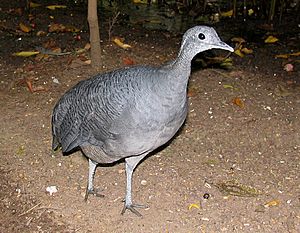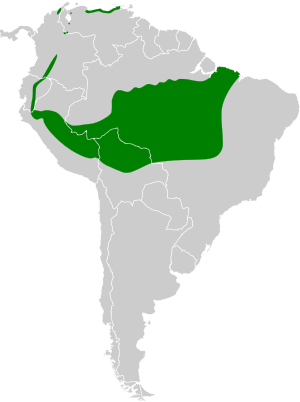Grey tinamou facts for kids
Quick facts for kids Grey tinamou |
|
|---|---|
 |
|
| Conservation status | |
| Scientific classification | |
| Genus: |
Tinamus
|
| Species: |
tao
|
| Subspecies | |
|
T. t. larensis (Phelps & Phelps, 1949) |
|
 |
|
The grey tinamou (Tinamus tao) is a special type of bird that lives on the ground in South America. It's known for its mostly grey feathers. There are four different kinds, or subspecies, of the grey tinamou.
Contents
About the Grey Tinamou
All tinamous belong to a bird family called Tinamidae. These birds are also part of a larger group known as ratites. Ratites are birds that cannot fly, like ostriches and emus. Interestingly, tinamous are the closest living relatives to ancient birds that could fly.
Types of Grey Tinamous
The grey tinamou has several subspecies, which are like different versions of the same bird. They live in various parts of South America:
- T. t. larensis: This subspecies lives in the montane forests (mountain forests) of central Colombia and northwestern Venezuela.
- T. t. kleei: You can find this one in south-central Colombia, eastern Ecuador, eastern Peru, eastern Bolivia, and western Brazil.
- T. t. septentrionalis: This type lives in northeastern Venezuela and possibly northwestern Guyana.
- T. t. tao: This subspecies is found in north-central Brazil, far eastern Peru, and far northwestern Bolivia.
What Does It Look Like?
The grey tinamou is thought to be the biggest bird among all the tinamou species. It can be about 41.5 to 49 centimeters (about 16 to 19 inches) long. Some have even been measured up to 53 centimeters (about 21 inches)!
Size and Weight
Male grey tinamous usually weigh between 1325 and 1863 grams (about 2.9 to 4.1 pounds). The average weight for males is around 1565 grams (about 3.4 pounds). Females are a bit heavier, weighing from 1430 to 2080 grams (about 3.1 to 4.5 pounds). Their average weight is about 1636 grams (about 3.6 pounds), and some can even reach 2300 grams (about 5 pounds)!
Feather Colors
As its name suggests, the grey tinamou is mostly grey. Its back and head have blackish stripes. The feathers under its tail are a cinnamon color. It also has white spots on its head and neck.
Where Do They Live?
The grey tinamou can be found in many countries in South America. These include western and northern Brazil, eastern Ecuador, eastern Peru, Colombia (east of the Andes mountains), northern Venezuela, northern Bolivia, and Guyana.
Their Home Environment
In most places, the grey tinamou lives in humid lowland forests. These are forests that are wet and not very high up. However, in the northern and far western parts of its range, it mostly lives in montane forests, which are found in mountains.
Adapting to Changes
This bird has shown that it can live in forests that have been partly cut down by logging. Like most other tinamous, you can often hear its song in the forest. However, it is a very shy bird, so it's not often seen.
Behavior and Life Cycle
Like other tinamous, the male grey tinamou takes care of the eggs. He sits on the nest, which is hidden in thick bushes on the ground. After the eggs hatch, the male also raises the young birds. He looks after them for a short time until they are ready to be on their own.
What They Eat
Grey tinamous find their food on the ground and from low bushes. They mostly eat fruits and seeds.
Conservation Status
The IUCN (International Union for Conservation of Nature) keeps track of how many animals are left in the wild. The grey tinamou used to be listed as "Least Concern," meaning there were plenty of them. Its habitat covered a huge area of about 3,600,000 square kilometers (about 1,390,000 square miles).
Becoming Vulnerable
However, in 2012, its status was changed to "vulnerable." This means that the grey tinamou is now at risk of becoming endangered if we don't protect its habitats.
See also
 In Spanish: Tinamú tao para niños
In Spanish: Tinamú tao para niños


